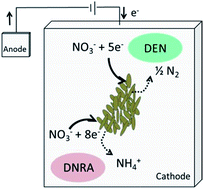Dissimilatory nitrate reduction to ammonium as an electron sink during cathodic denitrification
Abstract
Dissimilatory nitrate reduction to ammonium (DNRA) is an undesired pathway occurring simultaneously to denitrification in natural environments as well as engineered systems aimed at biological nitrate reduction/removal. Ammonium formation has previously been detected in cathodic compartments of bioelectrochemical systems performing denitrification, although reported concentrations are generally very low. In order to demonstrate and quantify the occurrence of DNRA from nitrate in a mixed culture denitrifying cathodic biofilm, a carbon cloth working electrode was inoculated with a denitrifying microbial community and poised at −0.9 V vs. standard hydrogen electrode, while nitrate (20 mg L−1 NO3−-N) was continuously fed at an HRT of 10 hours. Results showed that more than 40% of nitrogen added as nitrate was converted via DNRA when the biofilm was at initial stages of development. However, ammonium generation decreased to approximately 5% at later stages of development (7 months of operation), indicating that biofilm age plays a key role on biological pathways occurring during cathodic nitrate reduction. A closer insight revealed that the occurrence of DNRA is linked to cathodic coulombic efficiency: at low efficiency, a large fraction of the incoming electrons are converted to hydrogen or other reduced compounds within the biofilm, increasing the driving force for DNRA; at high coulombic efficiency, lower reducing power availability leads to nitrogen gas as preferred reduction product.



 Please wait while we load your content...
Please wait while we load your content...